#l330
Explore tagged Tumblr posts
Text




more of these fellas :)
#rottmnt#art#fanart#digital art#rottmnt leo#rottmnt fanart#rottmnt fanfic#rottmnt comic#comic#rottmnt art#L330-N: Flesh & Blood
944 notes
·
View notes
Text
GORE/BLOOD WARNING!!

Some fun mixed media ideas for later :)
#l330-n: flesh & blood#art#rottmnt fanart#comic#digital art#fanart#rottmnt#rottmnt art#rottmnt comic#rottmnt fanfic#digital collage#collage#collage art
26 notes
·
View notes
Text








found these photos on my mom’s cameras.
4 notes
·
View notes
Note
Can we know the list of all aus that were submitted, even if they didn't make it in?
Yeah sure! Under read more. Creators aren’t listed, but if u wanna know a creator lmk!
Timeblind- 1
Cannibalism/Resurrection - 4
Hidden City Hijinks- 1
Remember Forever - 5
MaskFace - 1
Cursed Treasure - 1
Miwa - 1
Torinokasa Reta AU - 1
Mama Bear - 4
TMNT: Mutate - 1
Prison Dimension Turtles - 6
Kid Leo - 3
A Mirror’s Reflection - 1
Prodigy (Runtverse) - 12
Head Over Boots - 1
The Nexus Heir - 1
Little Warrior - 1
The Monster Inside - 4
Impromptu Apocalypse - 7
Warrior’s Heart - 1
MultiMutantVerse - 1
TMNT: Pure Soul - 1
Spiderlings - 1
Fear’s Embrace - 5
Wanderer - 6
Light As A Feather, Stiff as a Turtle - 9
Just Around the Corner - 3
Mutant Ninja Midlife Crisis - 1
Cracked Conscience - 1
Even More of a Disaster - 3
Life of Violence Era - 1
Firefight - 2
The Canary Continuity - 3
Omniverse - 1
The Day the World Broke - 2
Purple Delusions - 4
Dragon / Fairy AU -1
ReviSplinter AU - 1
Krang Infection - 1
It’s A Complicated Equation - 1
Turtles all the way down - 1
Catch You - 1
Hamato Wanderers - 1
Separated Leo - 3
True Colors - 6
Revelations Timeline - 1
The Little Prince - 2
Soulmates (Evil) - 1
Possessed AU - 1
Indie TMNT - 3
The Mutation Situation - 1
Rise of the Parallel - 1
Lost but Not Forgotten - 1
Endless Void - 3
Old Soul - 1
Lost Standing - 1
Imaginary Friends AU - 1
Tizeline Sep AU - 4
A Bit Too Vibrant, A Bit Dull - 2
Microwave - 2
Feral Leo - 1
TMNT: Tainted - 1
A New Family - 1
I May Be Invisible But I Still Look Good - 2
A Useless Death - 1
Kendratello AU - 1
LFLS - 1
Little Brother - 2
The Neon Void - 4
You’ve Been Portal Jacked! - 2
Here there be turtles - 2
I Care - 3
The Last Something that meant anything - 5
Teenage Mutant Neglected Turtles - 1
Universal Mayhem - 3
And It All Falls Apart - 4
Sub Zero AU - 5
Black and Brown Fur - 2
Dimension Hopper Leo - 9
The Pedagogy or Life - 1
Fearless - 1
Blood is Thicker Than ooze - 1
Eyes on You - 1
Collide - 1
Lav’s TMNT iteration - 1
Little Subjects - 1
Gemini AU - 1
Ashes Ashes Dust to Dust - 3
Pixie Hollow AU - 2
Same as it never will be - 1
Cross Dimension Kidnapping - 1
Sibling Quest 202X - 3
Reciprocity - 2
Puppet Tightly Strung - 1
TMNT Killer - 1
Three Sided Coin - 1
Unlikely Bonds - 2
Tiger Sister - 1
Goosey Leo - 2
That Fangs - 6
Captain X2 - 6
Ides of March - 1
L330-N AU - 1
Good Genes - 2
Perfect Son - 1
Little Artemisia - 1
Krangified AU - 1
Paying for the Mistakes - 1
TMNT: Abnormality - 1
Mirror Maze - 1
I’m Sorry, Teenage Mutant What Now? - 1
Never Better - 1
Letter From my Future Self - 2
TMNT Dual Team - 1
Point Zero: REstart - 2
Casey Jr Chronicles - 1
TMNT: Clan - 1
The Blue Guard - 1
Leonardo Come Down - 1
Down with the stockholm - 1
DragonTurtle AU - 1
Building Trust - 3
Mystic Prodigy - 1
Clarification - 2
TMNT: Mismatched Set - 1
Feral Casey - 17
F1 AU - 3
Double Mutated Mikey - 1
VelCro Duo - 1
Open Your Shell and Find Your Wings - 1
Bad end Ninja Turtles - 1
Lou Jitsus Kids - 2
Void Brothers - 1
Addams Family - 5
TMNT: Apex - 1
Scout - 3
TMNT: Dusk and Dawn - 1
No Fun in Fungus - 4
Turtle Wrench - 1
Froyo! - 1
Merrow’s Iteration - 1
Until I found you - 7
Step-Brothers - 1
Please Don’t Leave (I Need You More Than You Need Me) - 1
2 Arms Left - (INVALID)
Cinder-Leo - 3
Built to Kill - 1
Turtleverse - 3
Pokemon AU - 2
Onryo - 2
Hunger Games AU - 2
Tangled Shells - 5
In The Real World - 1
TMNT Story Comp - 5
Things Will Be Fine - 1
Fire and Rain - 1
Teenage Mutant Kunoichi Turtles - 1
Call Me Here - 1
Teenage Mutant Royal Turtles - 1
Mutant Manhunt - 1
Gravedigger - 1
Spikey Mikey - 1
Emotional Support Water Bottles - 3
Rise Kingdom of Hearts AU - 1
Cass Apoc Series - (INVALID)
Teetlezverse - 4
Rise in Hell - 1
22 notes
·
View notes
Note
Hey, have you seen Angelpuns's update about their new upcoming game L330-N Flesh N' Blood? Are you play once it's out?
Sorry, got no idea what that is 😅
4 notes
·
View notes
Text
WAHHHHHHH YELLINF SCREAMINF CRYING AHAHDHDHDH

Made fan art for @angelpuns L33 AU
It was fun- but it’s 1am and I’m tired, time to eep-
73 notes
·
View notes
Text
Huntkey HK36O ATX Thermal Computer Casing
Huntkey HK36O ATX Thermal Computer Casing Metal Dim: L330*W180*H412mm at Huntkey HK36O ATX Thermal Computer Casing. Case Dim: L345*W180*H412mm Case Color: Black Metal Material: 0.45mm SPCC M/B: ATX/M-ATX/Mini-ITX Storage: 3.5’HDD*1/2.5’SSD*2 Product Description Metal Dim: L330*W180*H412mm Case Dim: L345*W180*H412mm Case Color: Black Metal Material: 0.45mm SPCC M/B: ATX/M-ATX/Mini-ITX Storage:…
0 notes
Text





32) Tatarzy Baraba, Baraba Tatars, Baraba, Бара́бинцы, Barabińcy, (tatarski syberyjski: параба, бараба, барама, бараба татарлар) - podgrupa Tatarów syberyjskich i rdzennej ludności międzyrzecza Ob-Irtysz. Po zaciekłym oporze wobec rosyjskiego podboju i wielu cierpieniach w późniejszym okresie z powodu najazdów Kirgizów i Kałmuków, obecnie utrzymują się z rolnictwa – albo w oddzielnych wioskach, albo razem z Rosjanami. Niektórzy z nich nadal mówią dialektem Baraba języka tatarskiego syberyjskiego. Tradycyjnie zamieszkują step Baraba. Po raz pierwszy zostali wymienieni jako odrębna grupa etniczna w spisie ludności Imperium Rosyjskiego w 1897 r. i pierwszym ogólnozwiązkoym spisie powszechnym Związku Radzieckiego w 1926 r. Według spisu ludności z 1897 r. liczyła ona 4433 mieszkańców. W 1926 r. było 7528 Tatarów Baraba. Etnografowie oszacowali, że w 1971 r. ich populacja osiągnęła 8380 osób. Według danych Instytutu Filologii Syberyjskiego Oddziału RAS w 2012 roku w obwodzie nowosybirskim przebywało 8 tys. Tatarów Baraba. Tatarzy Baraba są potomkami plemion Kipczaków, które zamieszkiwały ten region w XII i XIII wieku. Region został podbity przez Mongołów w XIII wieku i został włączony do Białej Ordy. Tatarzy Baraba zamieszkiwali wschodnią część Chanatu Sybirskiego w momencie jego powstania w XV wieku. W XVIII wieku Rosjanie podbili Tatarów Baraba. W XIX w. autonomia Tatarów Baraba uległa erozji w związku z napływem rosyjskich osadników do regionu i wysokimi podatkami nakładanymi na nich przez państwo rosyjskie. Rosyjscy osadnicy wyparli Barabę z żyzniejszych ziem. Chanat Dzungar odebrał yasaq (daninę) swoim muzułmańskim podwładnym Baraba. Przejście na prawosławie i zostanie poddanymi rosyjskimi było taktyką Baraby mającą na celu znalezienie wymówki, aby nie płacić yasaq Dzungarom. Ponieważ muzułmańscy syberyjscy Bucharanie mieli prawne korzyści i przywileje pod władzą Rosji, Barabas udawał, że jest nimi. Tatarzy Baraba są muzułmanami sunnickimi. Przyjęli islam mniej więcej w drugiej połowie XVIII wieku. Jednakże Tatarzy Baraba mogli mieć kontakt z islamem już pod koniec XVI wieku, a niektórzy mogli być muzułmanami już na początku XVII wieku. Baraba Tatarzy tradycyjnie zajmowali się polowaniem, rybołówstwem, rolnictwem oraz hodowlą bydła i koni. Najpowszechniejszą haplogrupą Y-DNA wśród Tatarów Baraba jest haplogrupa Q, w szczególności podklady Q-YP4000 i Q-L330. Wśród północnych Tatarów Baraba najbardziej rozpowszechniona jest haplogrupa N1b-P43. Inne, mniej powszechne haplogrupy to R1a1-Z93 i R1b-M73.
Część Tatarów syberyjskich, rdzennej ludności tureckojęzycznej zamieszkującej tereny pomiędzy rzekami Ob i Irtysz. Podobnie jak większość Tatarów syberyjskich, nie wyróżniają się oni jako odrębna społeczność etniczna i uważają się za Tatarów. Barabinowie są wymienieni jako odrębna ludność w spisach ludności z lat 1897 i 1926. Według spisu z 1897 r. liczba mieszkańców Barabina wynosiła 4433 osoby. W 1926 r. ich liczbę ustalono na 7528 osób. Według etnografów w 1971 r. liczba mieszkańców Barabina wynosiła 8380 osób. Według Instytutu Filologii Syberyjskiego Oddziału Rosyjskiej Akademii Nauk w 2012 roku w obwodzie nowosybirskim żyło około 8 tysięcy Tatarów Barabińskich. W Ogólnorosyjskim Spisie Powszechnym Ludności z 2010 r. uwzględniono obywateli identyfikujących się jako „Baraba” w ramach szerszej grupy etnograficznej – Tatarów syberyjskich. W rezultacie nie ma obecnie wiarygodnych danych na temat liczby osób identyfikujących się jako „Tatarzy Baraba”. Wśród ludności z syberyjskich wsi tatarskich trwają procesy asymilacji z jednej strony wewnątrz narodu tatarskiego, a z drugiej strony z większością rosyjską. Jest jeszcze inny punkt widzenia – wręcz przeciwnie, przybysze Tatarzy z Wołgi i Uralu asymilują się z Barabińskim tam, gdzie ci ostatni żyją zwięźle i na co dzień posługują się dialektem barabińskim. W XVI wieku Barabinowie byli częścią chanatu syberyjskiego, „byli za Kuczumem”. Chana syberyjskiego nazywano czasem nawet „synem stepów Baraba”, a same stepy i Urmanowie z Baraby były jego „miejscami rodzinnymi”. Mieszkańcy Baraby żyli w XVI wieku w małych osadach rozsianych po niemal całym stepie, skupionych częściej w pobliżu jezior, rzek Omi i Tara. Mieli także ufortyfikowane miasta - takie znane są w pobliżu jeziora Chany, Yarkul, wzdłuż rzeki Omi, zachowały się nazwy miast Tontura (w drugiej połowie XVI w. siedziba namiestnika Kuchum z Buyan-Biya), Tunus i inne. W 1628 roku wybuchło powstanie mieszkańców Baraby, oburzonych samowolą i wymuszeniami namiestników syberyjskich. Rebeliantom dowodzili książęta Barabin Kogutey, Kushluduk i Enbai. Rebelianci zniszczyli niewielki oddział kozacki, składający się z 18 Kozaków dowodzonych przez syna bojara. Zabili kilku kolekcjonerów jasaków, spalili jeden z fortów i splądrowali osadę innych Tatarów, którzy pozostali wierni władzom rosyjskim. Następnie powstańcy wyemigrowali z granic posiadłości rosyjskich na ziemie Teleutów w rejonie Górnego Obu. Wzmianki o Barabinach pojawiają się w notatkach podróżniczych Lorenza Langa z lat 1715-1718:
"Dalej ścieżka wiodła przez Barabę – duży step, którym trzeba było udać się do Tomska. Na stepie, gdzie były bagna, rosły brzozy i inne drzewa. Zimą mieszkają tam Tatarzy; Rosjanie nazywają ich Tatarami Barabińskimi. Latem migrują do rzeki Tary i innych małych rzek".
Tatarzy Baraba zamieszkują południowo-zachodnią Syberię, na wschód od Uralu i na północ od Kazachstanu. W XIII wieku ludność południowej Syberii znalazła się pod kontrolą Mongołów. W rezultacie zaakceptowali i przyjęli wiele aspektów kultury mongolskiej. Tatarzy tego regionu przyjęli islam w XIV wieku. Pod koniec XVI wieku Imperium Rosyjskie przejęło kontrolę nad południowo-zachodnią Syberią. Tatarzy Baraba to podgrupa Tatarów syberyjskich. Tatarzy Baraba mówią w��asnym dialektem języka tatarskiego. Tatarzy syberyjscy kształcą się w szkołach języka rosyjskiego. Jednak do dnia dzisiejszego zachowali używanie własnego języka i wiarę w islam. Język tatarski syberyjski został zapisany cyrylicą w 1939 roku. Nie wiadomo, czy na język syberyjski baraba-tatarski przetłumaczono jakiekolwiek Pismo Święte lub materiały chrześcijańskie. W tradycyjnej kulturze tatarskiej mężczyźni zajmowali się łowieniem ryb, polowaniem i hodowlą zwierząt. Kobiety opiekowały się dziećmi, a podczas krótkiego lata uprawiały jęczmień, ziemniaki i groch. Od powstania Związku Radzieckiego na początku XX wieku Tatarzy syberyjscy byli „rusyfikowani”. Zostały one włączone do dominującej kultury rosyjskiej. Tatarzy nauczyli się mówić po rosyjsku, wstąpili do Armii Czerwonej, pracowali w sowieckich fabrykach i sowieckich kołchozach. Stalin patrzył na Tatarów podejrzliwie ze względu na ich praktykowanie islamu. Wielu Tatarów syberyjskich zostało przymusowo wysiedlonych ze swojej ojczyzny do innych części Związku Radzieckiego. Wielu Tatarów syberyjskich zdobyło uznanie jako bohaterowie wojskowi podczas II wojny światowej. Konie pozostają dużą częścią społeczeństwa tatarskiego. Tatarzy nadal wykorzystują konie do transportu i rekreacji. Mięso i nabiał stanowią główną część diety Tatarów. Podczas swoich tatarskich świąt noszą tradycyjne, kolorowe stroje, tańczą i śpiewają epickie pieśni tatarskie. Zdecydowana część Tatarów syberyjskich podaje się za muzułmanów sunnickich. Mała grupa twierdzi, że nie ma żadnych przekonań religijnych. Religia ludowa i wiara w duchy natury silnie wpływają na ich odmianę islamu. Sunnici są największą gałęzią islamu. Starają się przestrzegać nauk Koranu i proroka Mahometa. Sunnici wierzą, że przestrzegając pięciu filarów islamu, po śmierci osiągną niebo. Jednakże Allah, najwyższy Bóg wszechświata, decyduje o tym, kto wejdzie do raju. Sunnici modlą się pięć razy dziennie twarzą do Mekki. Poszczą w miesiącu Ramadan. W piątek uczęszczają na nabożeństwa w meczecie. Jeśli muzułmanin ma na to środki, raz w życiu uda się z pielgrzymką do Mekki. Muzułmanom zabrania się także picia alkoholu, jedzenia wieprzowiny, hazardu, kradzieży, stosowania oszustwa, oszczerstw i tworzenia bożków. Dwa główne święta muzułmanów sunnickich to Id al Fitr, przerwanie miesięcznego postu, i Id al Adha, świętowanie gotowości Abrahama do poświęcenia swojego syna Allahowi. Tatarzy często obchodzą święta chrześcijańskie.
0 notes
Text




Here's Donnie's basic sprites! The only sprites I need to make for him (aside from any extra ones for plot things) are the side idle animations :)
#rottmnt#art#fanart#digital art#rottmnt leo#rottmnt fanart#comic#rottmnt fanfic#rottmnt comic#rottmnt art#L330-N: Flesh & Blood
468 notes
·
View notes
Text
Little Update: Stairs :)
Yayyy
My plan rn is to finish the entirety of the prolouge before anything else, and then I will make that a Demo while I work on the rest of the game :) It will also help me figure out what's working and what's not so yayy
( can't remember if I already said all this or not but yeah )
20 notes
·
View notes
Text
Rippa L330 Mini New Excavator Earth Moving Machinery 2 Ton Mini Crawler Excavator By: Shandong Rippa Machinery Group Co Ltd https://youtube.com/shorts/I0WecPEm0Qk?feature=share #Excavator
0 notes
Text

Today in Panaque - A bit of a time ago, a pleco much like the royal pleco (but spotted) was discovered and called L330. Someone also gave it the nickname of watermelon pleco. (Why watermelon?)
It now has a proper name, a very interesting proper scientific name, it’s a mouthful:
Panaque nigrolineatus laurafabianae
Source - another source - image source
A different POV, worth the quick read
#pleco#plecostomus#fish#L330#watermelon pleco#panaque nigrolineatus#panaque#pleco news#taxonomy#loricariidae#royal pleco
6 notes
·
View notes
Photo




Làng chài
Biển Phan Thiết cuối mùa khô
.
Tháng 4/2016
6 notes
·
View notes
Text
Old School Staples Part 1: The Main Piece
Reposted from my serious blog [HERE]
Old School Lolita as a Time Period
Old School Lolita as a period in lolita history runs from the 1990s to about 2006 at the earliest and 2008 at the latest. Old School during this period is not a substyle as it is now, but just how people wore and styled lolita and encompassed all the substyles. 2006-2009 is a transitional period between the old way of styling lolita and the mergence of the 2010’s sweet style that was often much more OTT and print focused.
Here are examples of coords from this period ranging from what we think of as “Old School” style to sweet!

Old School Lolita as a Lolita Substyle
Old School Lolita as a substyle has become really popular over the past couple years. This substyle seeks to recreate the feel and look of early lolita. It is not the same as classic lolita or styling Old School pieces in modern ways. There are some very distinctive traits to the substyle based on trying to recreate the look based on trends of the 1990s to mid 2000s. For some Old School purists, the Old School substyle should seek to emulate this time period as accurately as possible down to make up and using primarily vintage pieces. For me, Old School Lolita, doesn’t have to be constrained by using pieces from that time frame. Finding those pieces can be rather expensive, time consuming, and often they are not as size inclusive. Luckily there are more recent pieces and rereleases of older pieces that work for Old School which are more inclusive and cost friendly.
Now let’s break down an Old School coord into it’s pieces through a series looking in depth at each element used in lolita coords. In part one we’ll be looking at main pieces such as OP, JSK, and skirts.
The Main Piece
Old School Lolita is not constrained to a limited color palette of black and white. It includes florals, tartans, pastels, solids, simple prints. The important thing with your main piece is to make sure it fits the general silhouette or motifs of early lolita. The material of your main piece is important since chiffon and polyester were not commonly used until the 2010s. Most of the material for main pieces were made out of cotton, velveteen, or gobelin. The most commonly used laces weren’t net laces like we see on 2010s releases but rather torchon, cluny, and occasionally raschel. Dresses were lower poof than giant cupcake silhouette. Full shirring, partial shirring in the front of the bodice, elasticated long sleeves, detachable sleeves, and corset lacing were much more common. The complexity of the dresses come from primarily details like pintucks, ruffles, lace, scalloped hems and other construction techniques.
These are dresses and skirts that are modern and/or rereleases of Older Pieces that would work for old school styling:
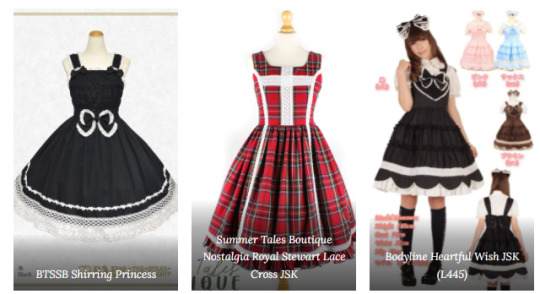
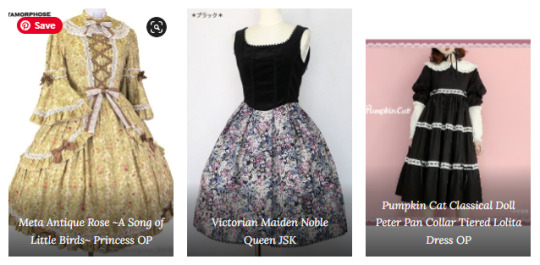

And these are that don’t really quite work.
Bodyline Glossy dress jumper skirt (L330)
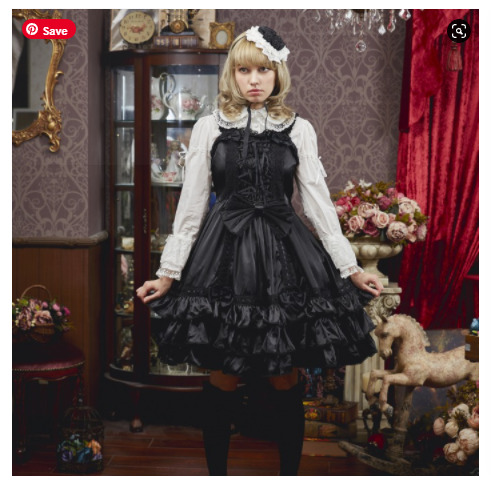
This bodyline jsk would be very tempting to use as a main piece due the face it’s only about $50, but I personally would avoid using this for Old School coords since it’s made from a glossy polyester which wasn’t really a common choice of material during the old school time period. The giant bow at the waist also reads more late 2000s to me but if you removed it, it would have been an good option if it were made from a cotton.
Rose Milk Candy Old School Lolita Dress
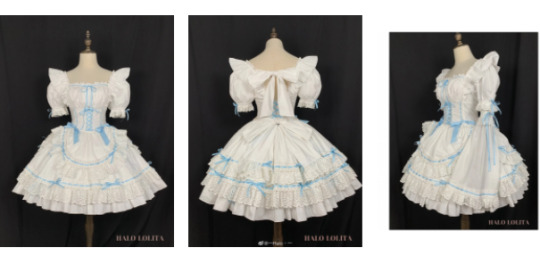
Devilinspired sponsered ads on my instragram keeps shoving this in my face and I don’t even know where to begin. How about here:

Old School… more like old school milanooo. While it does have some features that are shared with old school lolita appropriate dresses like ladder lace and ruffles, the silhouette isn’t really there and there’s elements you really wouldn’t have seen during the Old School period. Granted there are a bunch of weird releases from that period, but nothing looks like this. First off the bodice just screams maid costume. In the old school street snaps and ads, there are corsets and waist cinchers but you typically saw them more commonly in Elegant Gothic Aristocratic coords. They also didn’t super accentuate the waist to get the cupcake silhouette that this dress has. They were there as decoration or in the case of Vivienne Westwood style bustiers, cool pieces that were also status symbols. Aprons wore worn in lolita more commonly tended to wrap around the body or be straight up pinafores like with the BTSSB heart apron instead of just being a panel in the front.
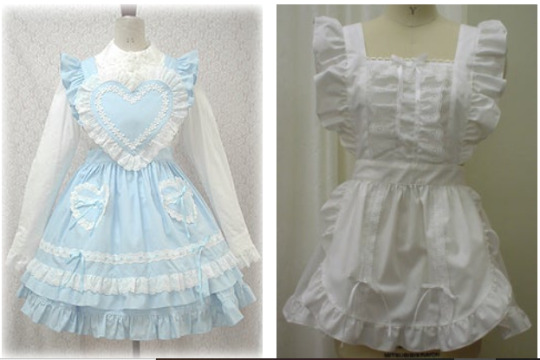
Lolita ops still today very rarely have low cut or open backs which also is another reason why I would personally steer clear of this OP for anything but a maid costume. The BTSSB heart apron has had a ton of rereleases including one this year! If you’re looking for a cute apron themed dress or skirt I would look for that one instead of whatever this monstrosity is. If you just chopped off the bodice… it could have been a decent skirt for old school… but the bodice just ruins everything.
Speaking of heart aprons, here’s a few Taobao releases that have the heart bodice which are super cute but I wouldn’t style in an old school manner.
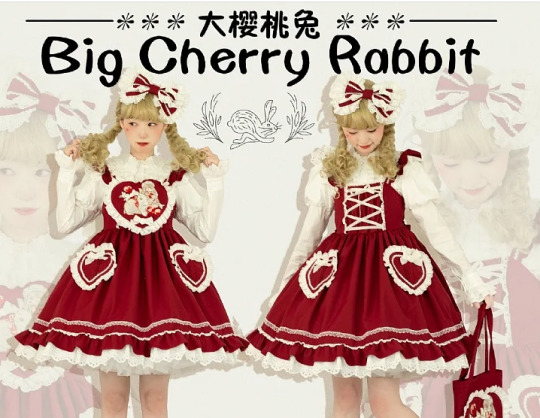
Complex Printed or embroidered designs beyond a simple logo on the heart part of a heart apron/pinafore started to appear in the 2010s and is a more sweet motif. Detaching the Heart from the Big Cherry JSK does result in a jsk that can be used in Old School cords if worn with a smaller petticoat so it’s a very versatile piece! Eyelet lace wasn’t as commonly seen, but it was sometimes used in older pieces as trim. I have a Heart E skirt that has eyelet lace as the trim of the hem.
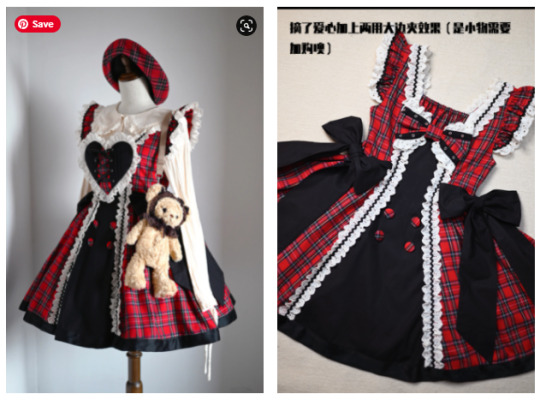
The Bowknot Mori Scotland Yard JSK is another one that might seem tempting to use in Old School because it is a tartan. However this one reads much more punk with the lace up heart, buttons, and large side bows. The heart is detachable but even detaching the heart, the resulting JSK is not something I’d personally us for Old School because the bows are just so large compared to similar releases with side bows from 1990s to 2000s.

And one final example of a JSK that I would not use in a Old School coord.
Angelic Pretty Flower Vacation JSK

This jsk has some things that we see in Old School, lower poof with more of an a-line silhouette, the lace that appears to be either chemical or torchon, ladder lace, and a simple print. However, this dress compared to other florals seen in the Old School time period has a major difference — the use of net lace and voile as trims. Moving some of the bows to be more situated around the skirt instead of up and down the dress would also give it more of an old school look. But overall, this really isn’t one that could be salvaged to work in an Old School coord because of the use of modern materials with out taking the scissors to the dress.
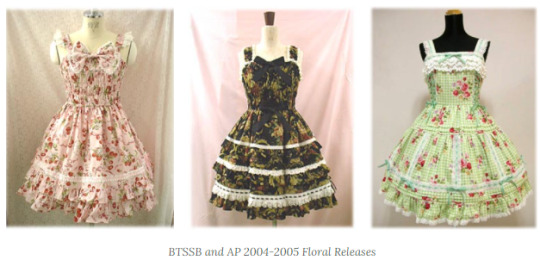
Summary
Things you want to look for in a main piece for Old School coords:
Low poof silhouette that is more a-line than cupcake
Fabrics: cottons (including twill), gobelin, or velveteen
Laces: Cluny, Torchon, ladder lace, and Raschel
Prints/Patterns: Solid colors, florals, very simple prints, tartans, and/or plaids
Detailing: Pintucks, ruffles, shirring, corset lacing, smaller bows, and/or scalloped hems
Things to avoid:
High poof silhouette that is very cupcake
Fabrics: shiny/glossy polyesters and chiffons
Laces: Net laces and anything that seems really crunchy or cheap
Prints/Patterns: Highly detailed prints (i.e. things like sugary carnival, cherry berry bunny, kumya’s marine island)
I recommend flipping through some old street snaps on Lolita History Gallery to see the wide range of styles that existed in the Old School Era and for ideas about what you’d like your main pieces to look like.
170 notes
·
View notes
Text
Huntkey GS450S ATX Thermal Computer Casing
Huntkey GS450S ATX Thermal Computer Casing Key Features Model: GS450S at at Huntkey GS450S ATX Thermal Computer Casing. Motherboard Support: ATX, M-ATX, Mini-ITX Pre-Install Fans: 3x 120mm ARGB Fans Extend slots: 7, Graphics card length: 305mm Max I/O Ports: USB3.0 x1, USB2.0 x2, Headphone x1, Mic x1 Metal Dim: L330*W200*H435mm Case Dim: L360*W200*H450mm Case Color: Black Metal Material: 0.5mm…
0 notes